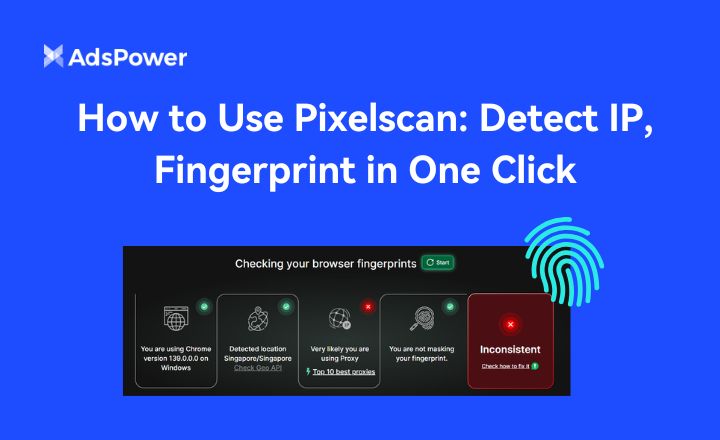Browser Fingerprinting vs Cookies: What’s The Difference?
With cookies taking their last breaths as large companies such as Google, move away from them, another tracking mechanism is on the rise.
We’re talking about browser fingerprinting, a technique that can effortlessly distinguish you from millions of other users.
In this article, we will focus on both tracking methods. We'll cover how they work, what data they collect, and highlight the key differences between browser fingerprinting and cookies.
What Are Cookies?
When you visit a website for the first time, it stores small text files on your computer or smartphone, called cookies. Websites use these files as notes to remember things about your visit, so they don’t have to disturb you again for that information. For example, a website can save a cookie to remember that you're logged in, so you don't have to log in every time you visit.
Initially, the idea behind cookies was to make browsing more convenient, for instance without cookies, online shopping carts would forget what you added as soon as you clicked on a new page, and sites wouldn’t remember your language settings or log in details.
However, as time passed cookies didn’t remain as innocuous. Companies realized that they could exploit cookies to understand who you are and what you like to do online. With this information, they could tailor ads to your personal likes and dislikes.
Taking it a step further, companies joined hands to plant each other’s cookies on their sites and use machine learning to build a more intricate profile of your habits. These cookies were called third-party cookies, and they enabled ads to follow you around the internet across websites and even on social media.
Now, what information do cookies collect? Well, it depends on the website and what it needs to remember. Here are some common types of information cookies collect:
● Session Information: Data such as how long you spend on each page, which pages you visit, and your navigation path through the site
● Preferences: Your settings and preferences like your language choice or the region you're in
● Login Information: Your username or a unique identifier to remember that you're logged in
● Shopping Cart Items: Cookies keep track of items you've added to your shopping cart as you continue to browse the site pages
● Ad Interaction Data: Which ads you've clicked on or interacted with to help advertisers deliver more targeted ads
● Device and Browser Information: Details such as the operating system, browser type and version, screen resolution, and device type
● Location Data: Approximate location information derived from your IP address
● Browsing History: List of visited websites, their subpages, and the time spent on each website
● Analytics: Recording date and time of visit can be used for analytics or to show you content updates since your last visit
Collecting such a long list of information, cookies, that started as a tool to remember user preferences, morphed into an advanced tracking mechanism. This tracking raised concerns about privacy and online surveillance. People didn’t like having their behavior analyzed without their explicit consent.
In response to growing privacy concerns, browser developers and regulators started taking steps to limit the use of third-party cookies. They started offering settings to block third-party cookies.
What Are Browser Fingerprints?
While global efforts increase to combat the use of cookies, with even browser developers taking a stand against them, a more pervasive tracking method, Browser Fingerprinting, remains largely unchallenged.
Browser fingerprinting is used by websites and online services to identify and track users without needing cookies or log in details. The technique looks at the unique features of your web browser and device to create a "fingerprint" that's different from everyone else's.
This process doesn't just look at one or two things. It examines a whole range of characteristics, so much so that it leaves no chance for two browsers to have identical fingerprints. For example, font fingerprinting detects the set of fonts installed on a user's PC. Given the hundreds of fonts usually found on PCs, even small differences in font lists can create a unique fingerprint.
The data collected for browser fingerprinting can include:
● User Agent String: Text identifying browser type, version, operating system, and device.
● HTTP Headers: Information sent with requests, including content preferences and encodings.
● Plugins and Extensions: Installed software details that indicate the user's software environment.
● Time Zone and Language Settings: Reflect the user's location and language preference.
● Screen Resolution and Color Depth: Display specifications that add to fingerprint uniqueness.
● Cookies and Local Storage: Data that reveals user's past website interactions.
● WebGL and Canvas Fingerprinting: Techniques that analyze graphical rendering for unique variations.
● Audio and Video API Fingerprinting: Information about how audio and video APIs are handled.
This is just a fraction of the data that contributes to browser fingerprinting. The full list can contain well over 60 data points about your device and software. You can visit AmIUnique.org to get a detailed view of your browser fingerprint.
This information is used not just for useful purposes like customizing your web experience but it can also be sold to advertisers, and government agencies, or fall into the hands of cybercriminals.
Collecting loads of device and software information solely for fingerprinting purposes blatantly under the user’s nose has raised significant privacy concerns. However, due to its robust nature, barely any solutions exist to effectively prevent browser fingerprinting.
Browser Fingerprinting vs Cookies: Key Differences
Both browser fingerprinting and cookies have unique ways of keeping tabs on what you do online, but they're pretty different in how they operate.
Cookies are files placed on your device by websites whereas browser fingerprinting runs scripts to gather information directly from your browser.
Another difference between browser fingerprinting and cookies is their main goals. Cookies are there to make your life easier by remembering stuff like what’s in your shopping cart, your login info, or how you like a site to look. On the other hand, browser fingerprinting exists to identify users, track their online behavior, and detect fraudulent activity.
The good thing about cookies is that you can find and delete them if you want to. Meanwhile, browser fingerprinting doesn't ask for your permission, and most people don't even know it's happening.
Here’s a quick overview of the key differences between browser fingerprinting and cookies:
|
Criteria |
Cookies |
Browser Fingerprints |
|
Stored on your device |
Yes |
No |
|
Creates a User ID? |
Yes |
Yes |
|
Informs the User? |
Yes |
No |
|
Asks for User’s Permission? |
Yes |
No |
|
Can be Deleted? |
Yes |
No |
|
Can effectively be prevented? |
Yes |
No |
AdsPower To The Rescue!
There are many tools that block cookies, and websites often ask users for permission to store cookies. But there are no such tools or measures when it comes to stopping browser fingerprinting. In fact, most users have no clue browser fingerprint is even happening.
Though browser fingerprinting is tough to beat due to its robustness, there are still some solutions around. The most effective method is to use an anti-detect browser like AdsPower, which can help you avoid browser fingerprinting to some extent.
This browser employs advanced anti-fingerprinting measures that feed fake data to trackers to hide your original identity.
Using AdsPower, users can tweak a large number of browser fingerprint metrics. In addition, it offers a feature to generate random fingerprints with a simple click.
And guess what? You can use AdsPower for free. The paid plans also start from just $4.5/month.
So, sign up today and download AdsPower for free to protect your information from intrusive websites.

People Also Read
- 8 Best Whoer Alternatives in 2026 ( Accurate & Private IP Check Tools)

8 Best Whoer Alternatives in 2026 ( Accurate & Private IP Check Tools)
Looking for a Whoer.net alternative? Discover our 2026 list of the 8 best IP check tools for accurate, private fingerprint analysis and enhanced onlin
- What Is WebRTC Used For? Does WebRTC Leak Your IP Address?

What Is WebRTC Used For? Does WebRTC Leak Your IP Address?
Learn what WebRTC is, what it's used for, whether it leaks your IP address, and how to stay protected with tools like AdsPower's WebRTC modes.
- What is BrowserScan? Check Fingerprints, IP Leaks & Stay Private

What is BrowserScan? Check Fingerprints, IP Leaks & Stay Private
What is BrowserScan? Find out how it detects IP leaks & unique fingerprints, plus tips for privacy with AdsPower.
- How Does AmIUnique Work and Is It Safe? Everything You Need to Know

How Does AmIUnique Work and Is It Safe? Everything You Need to Know
Discover how AmIUnique reveals your browser fingerprint, whether it's safe, the best alternatives, and expert tips to protect your online privacy.
- Pixelscan Review 2026: Features, Uses & Best Alternatives

Pixelscan Review 2026: Features, Uses & Best Alternatives
Pixelscan lets you check your IP and fingerprint; discover the best alternatives of Pixelscan to enhance security and privacy online.


